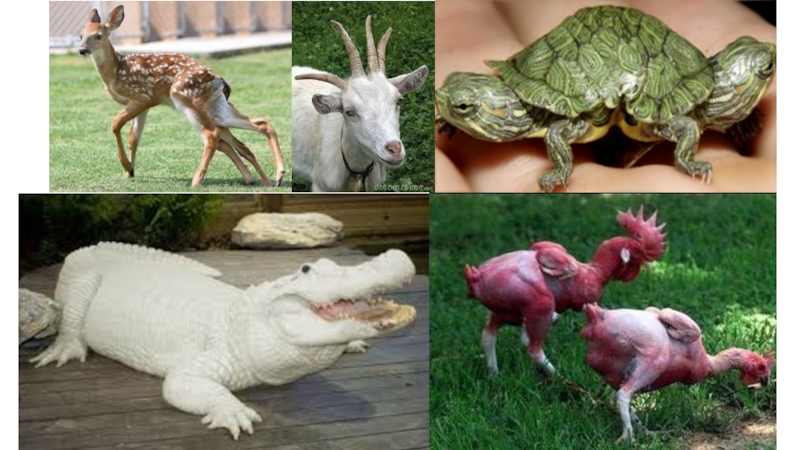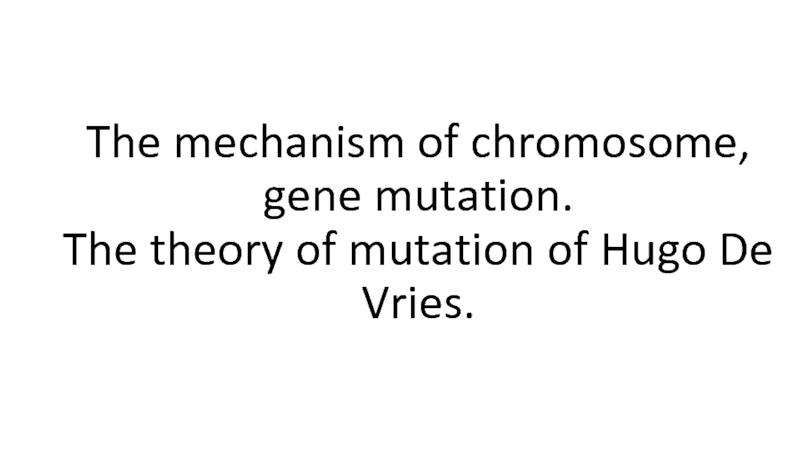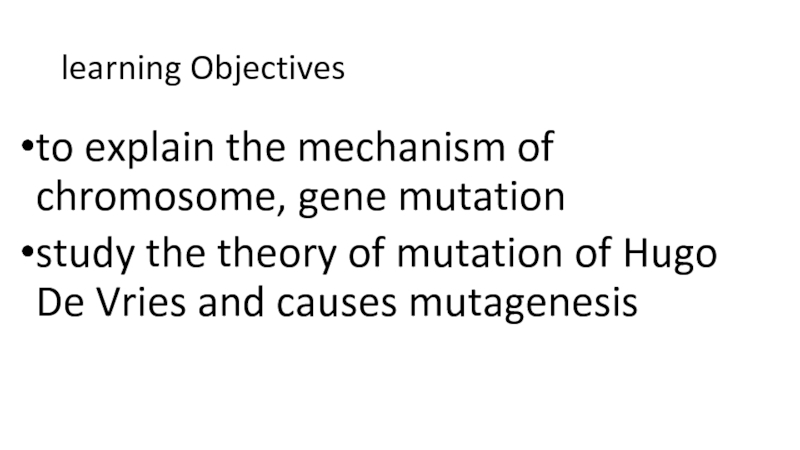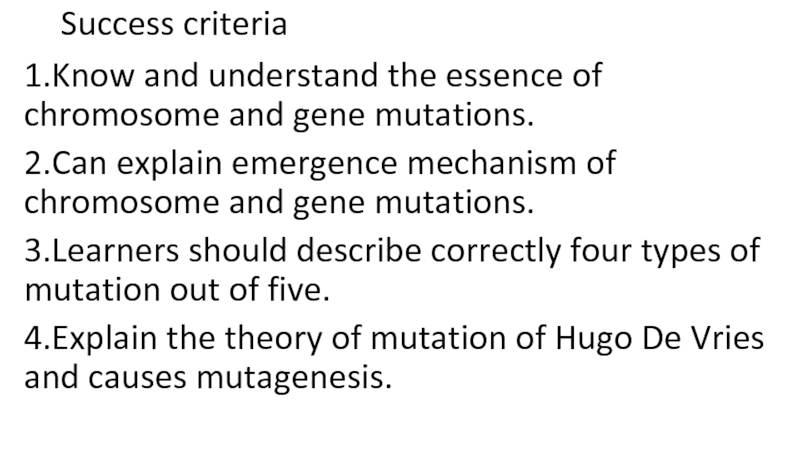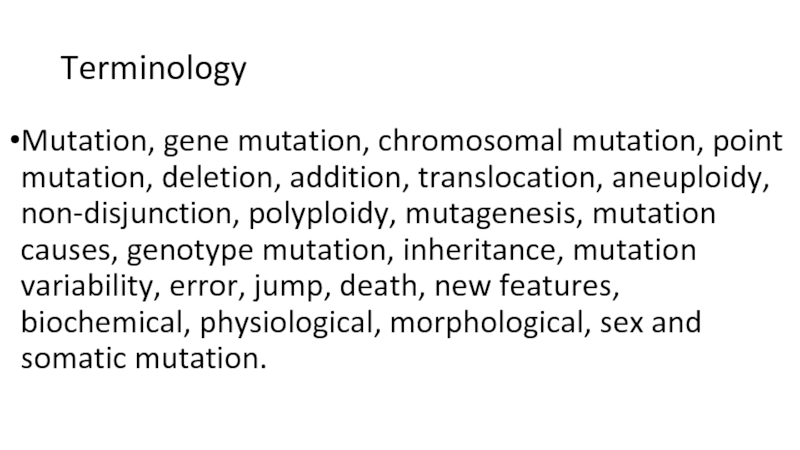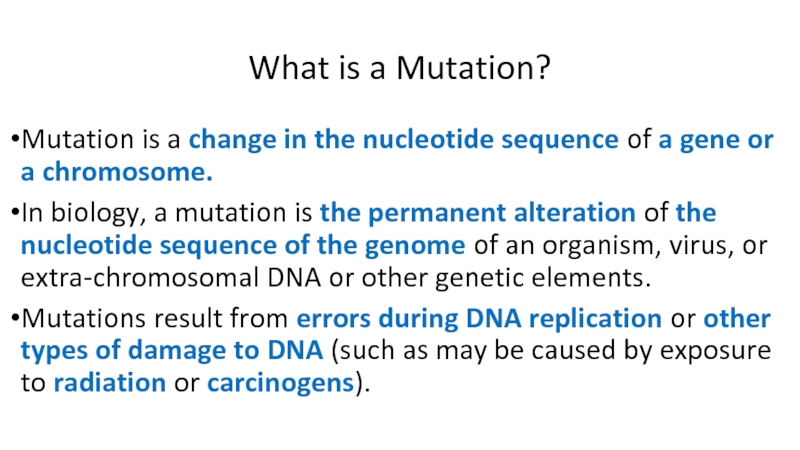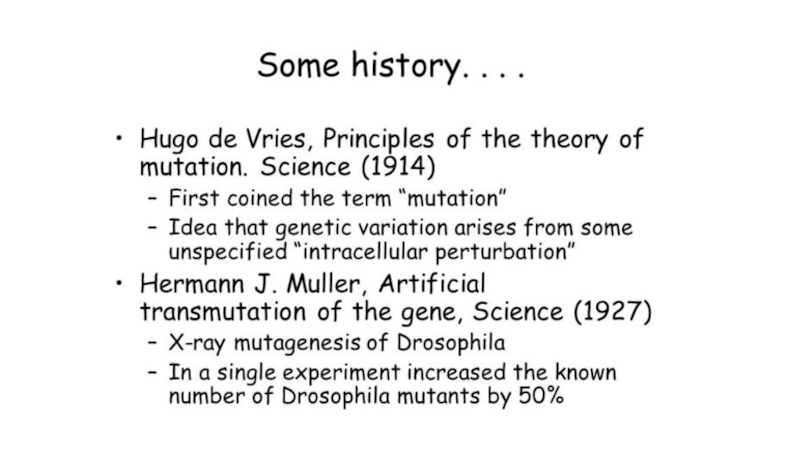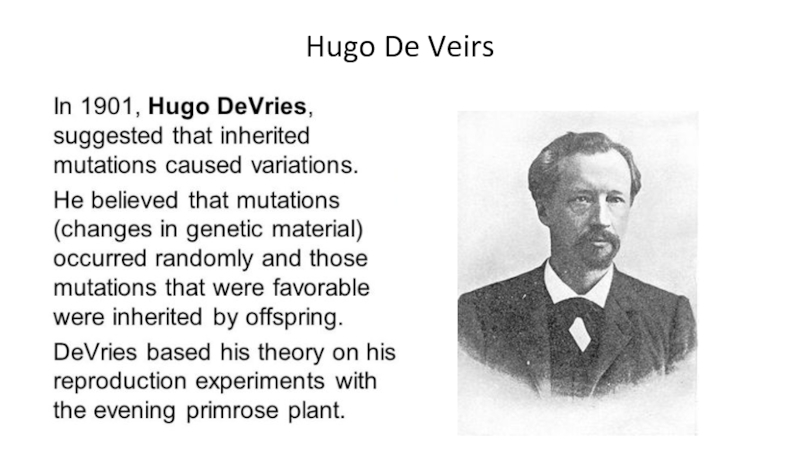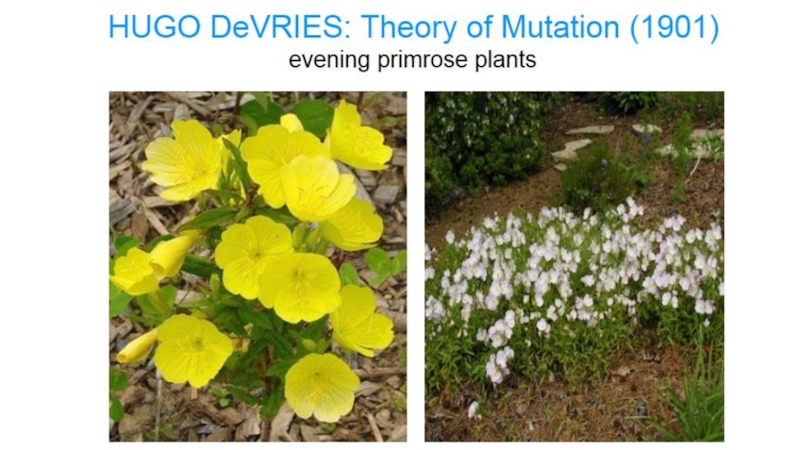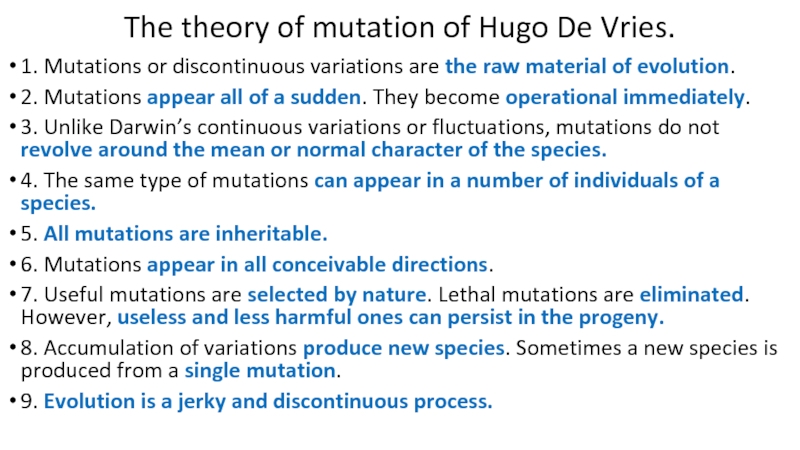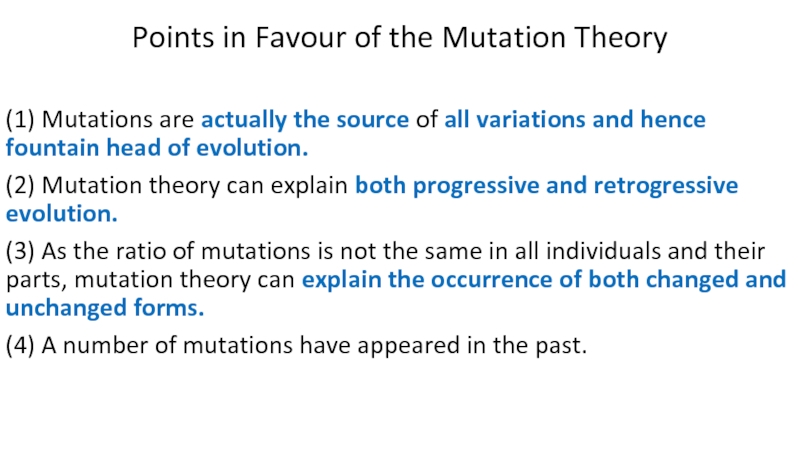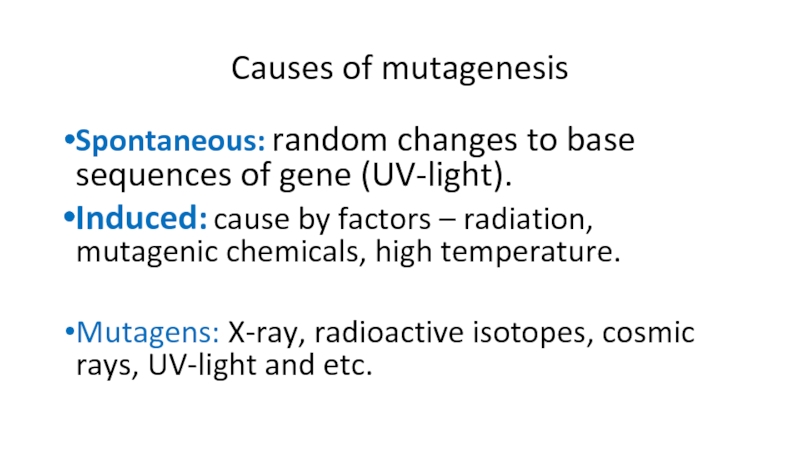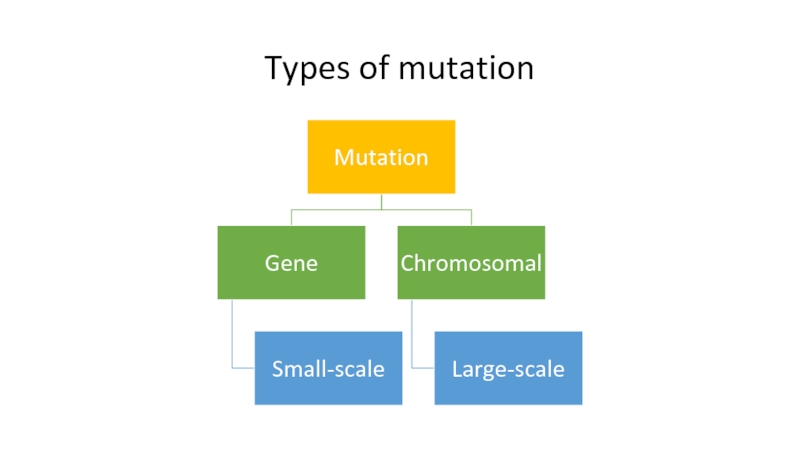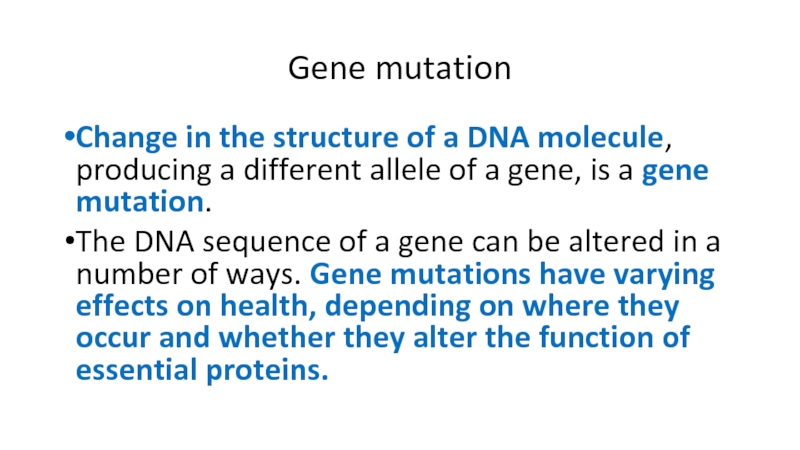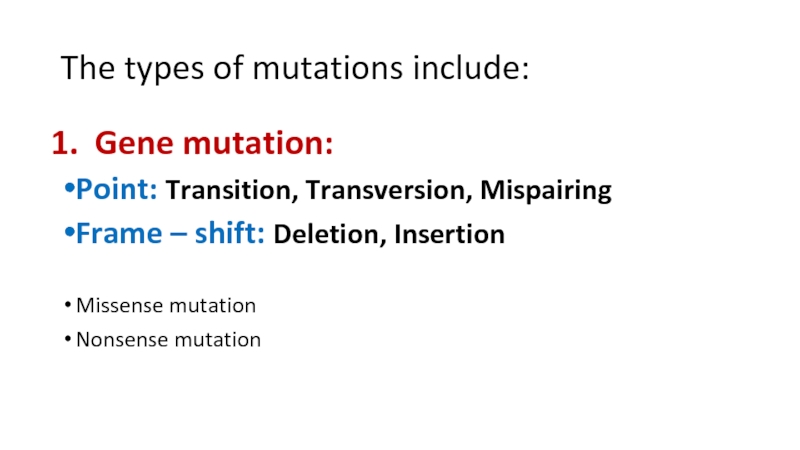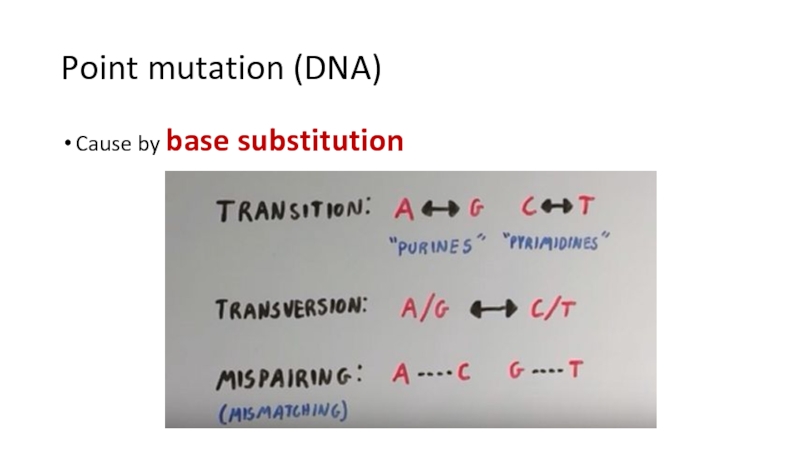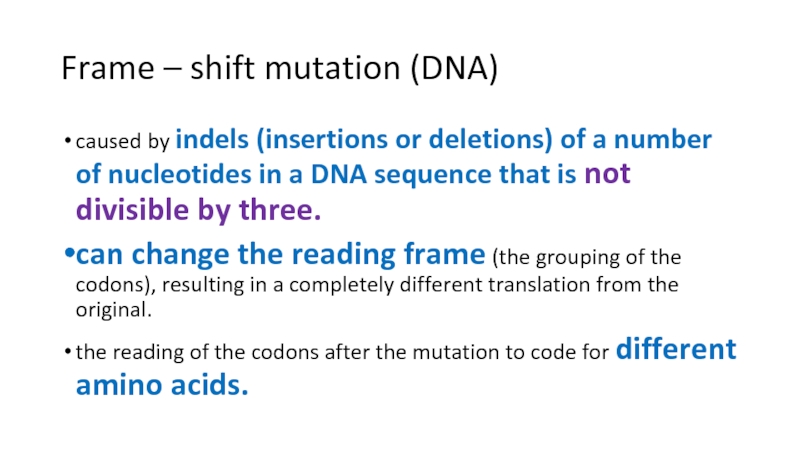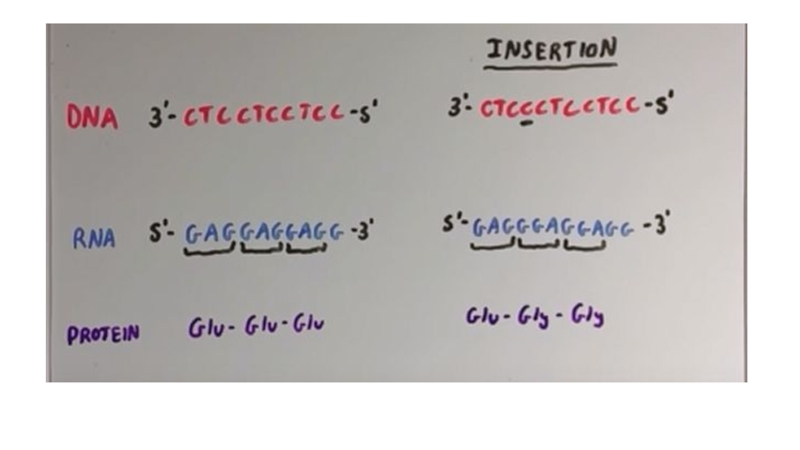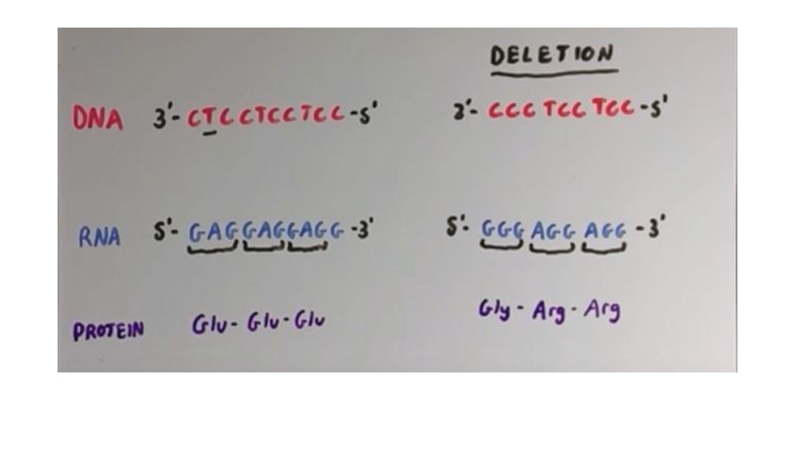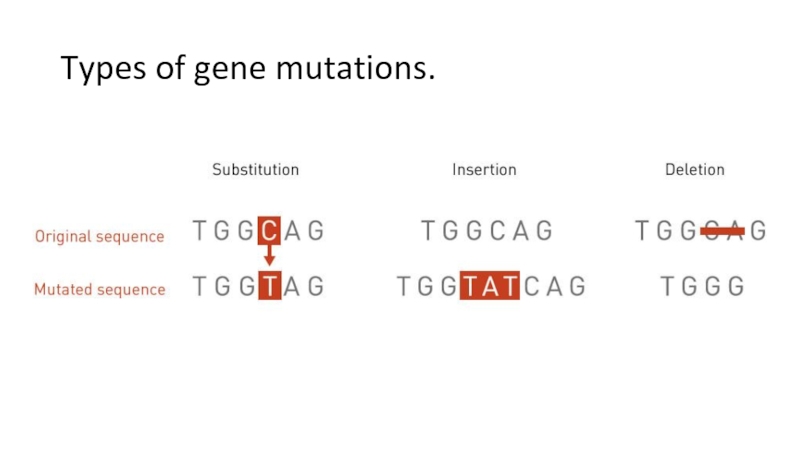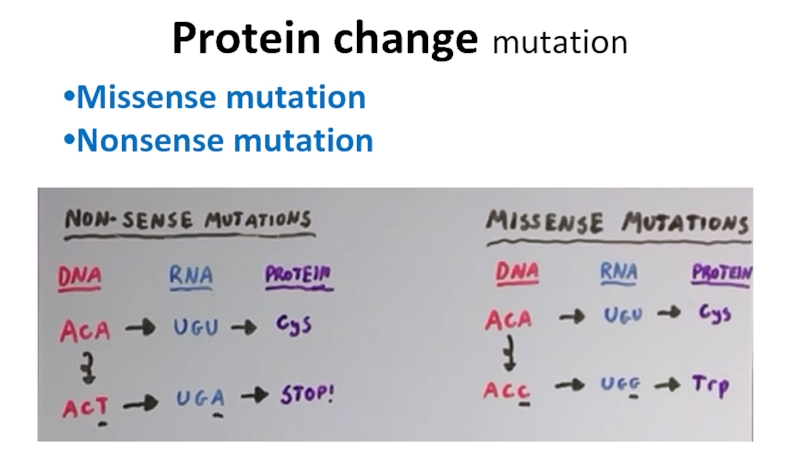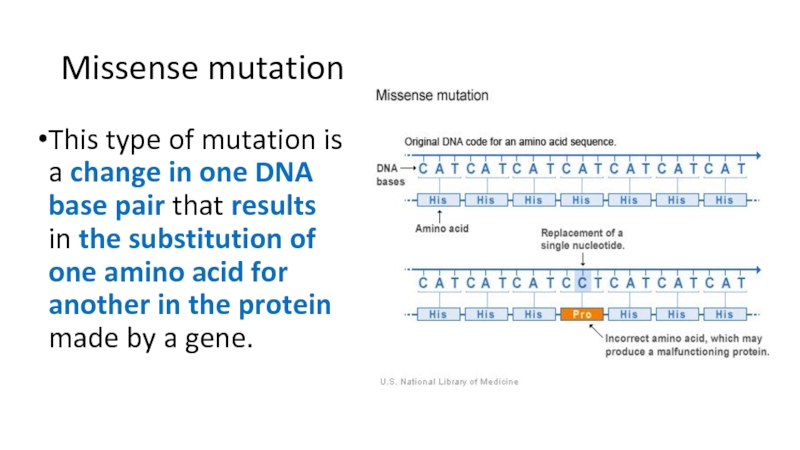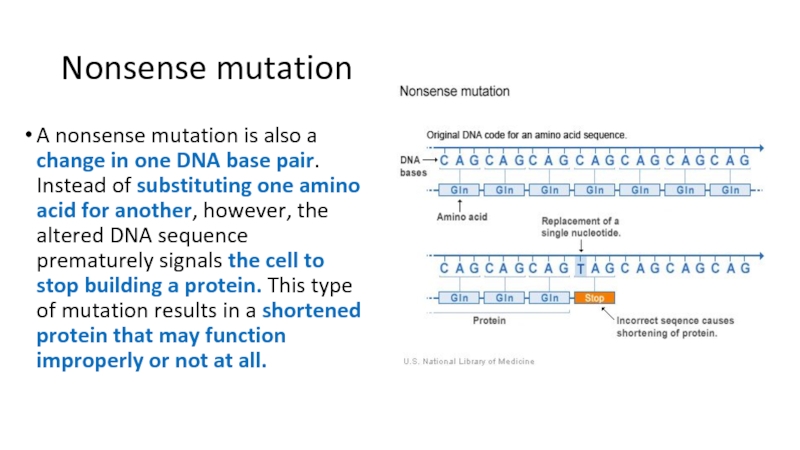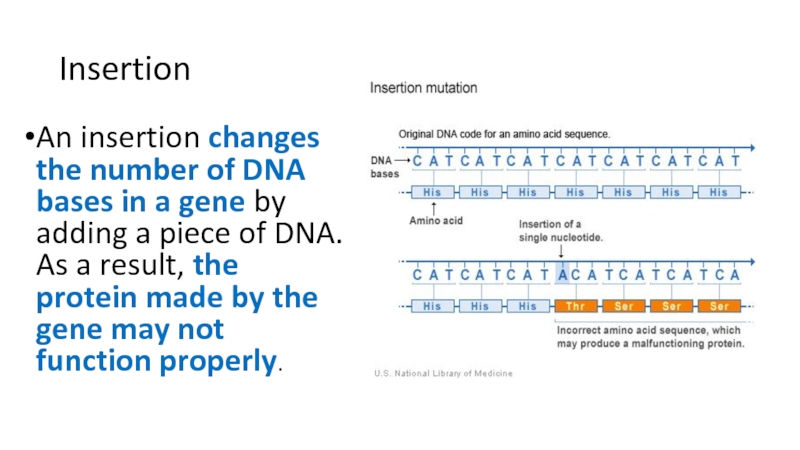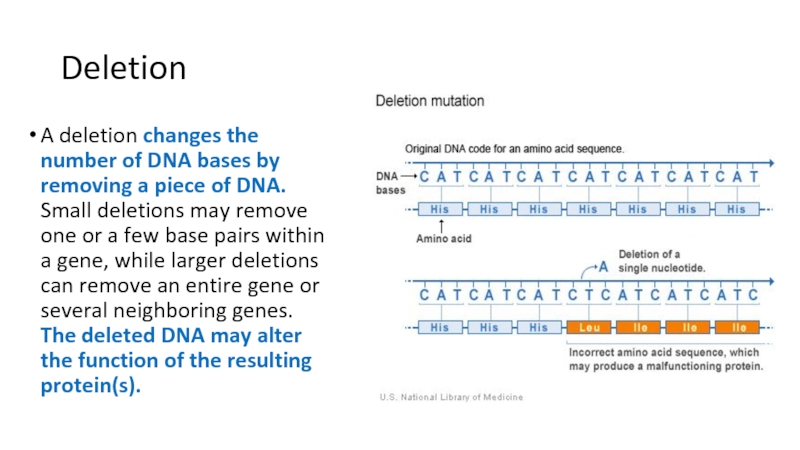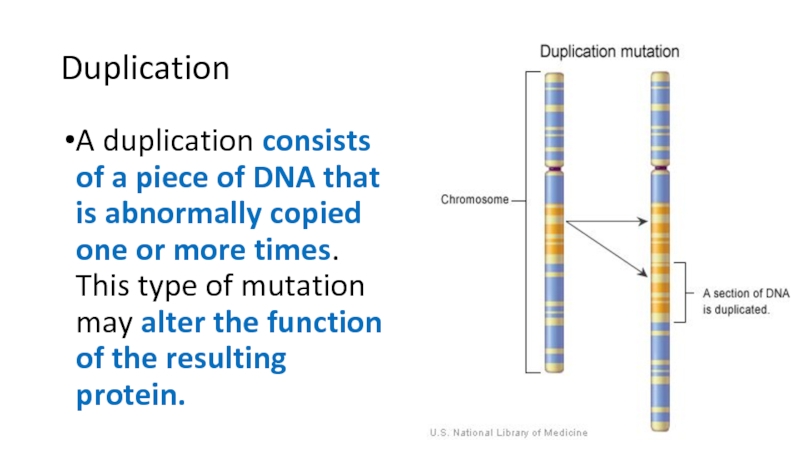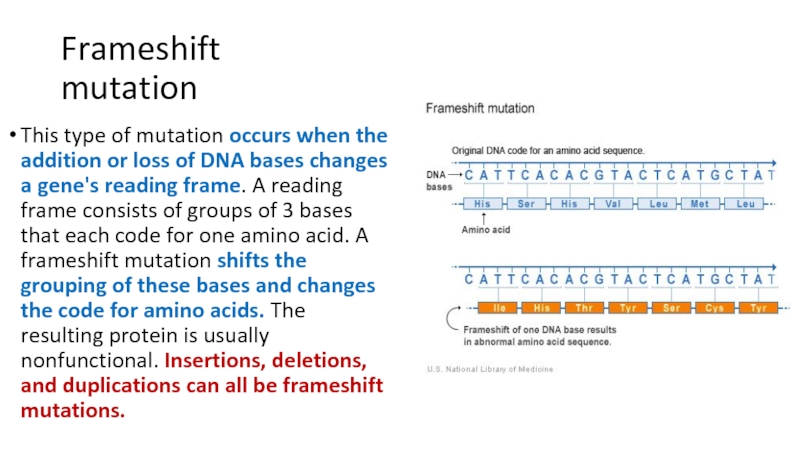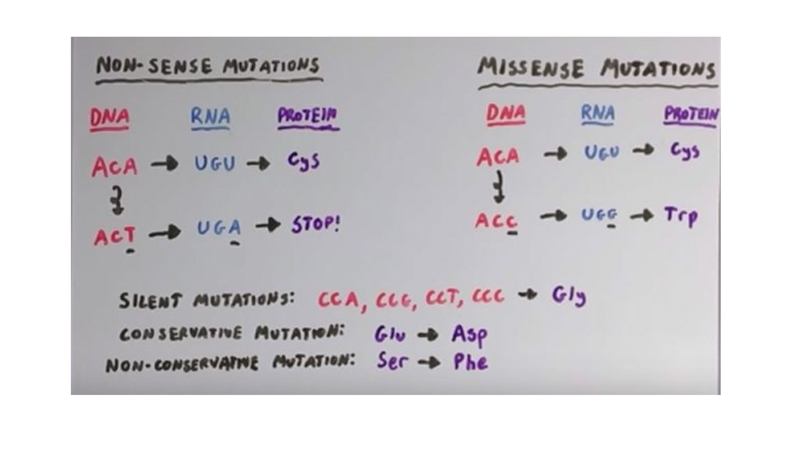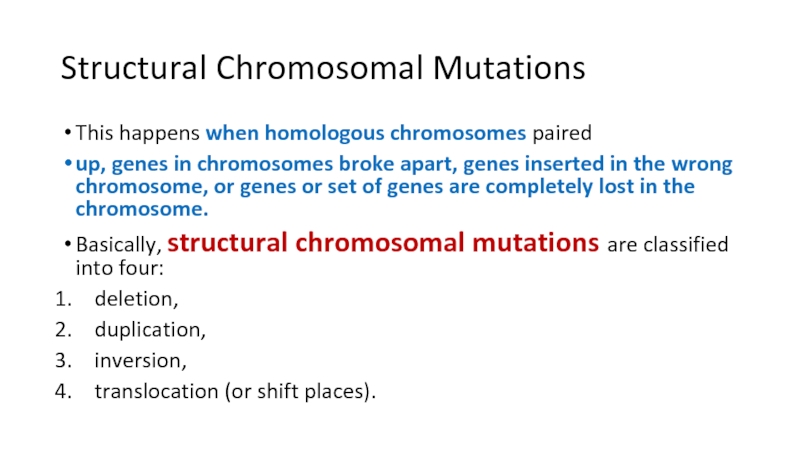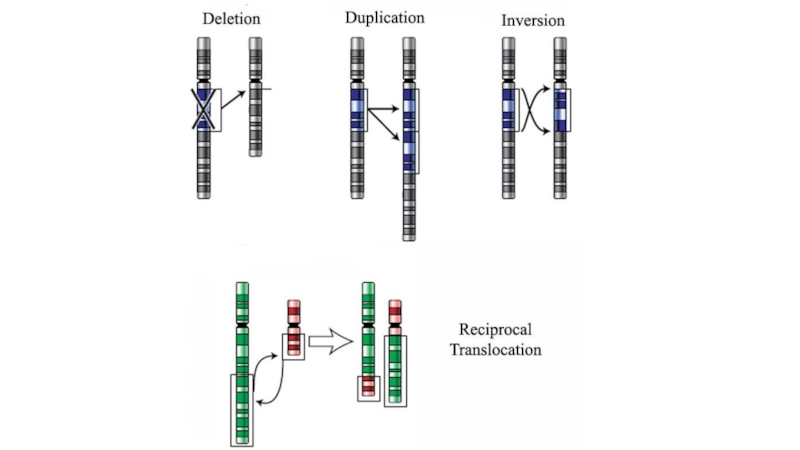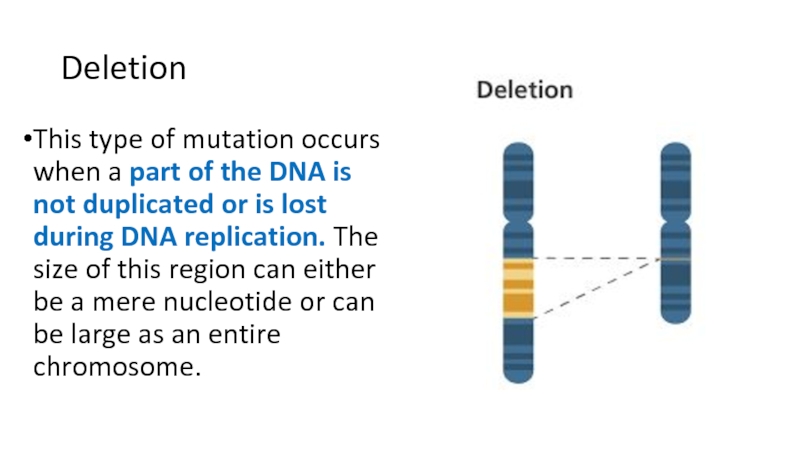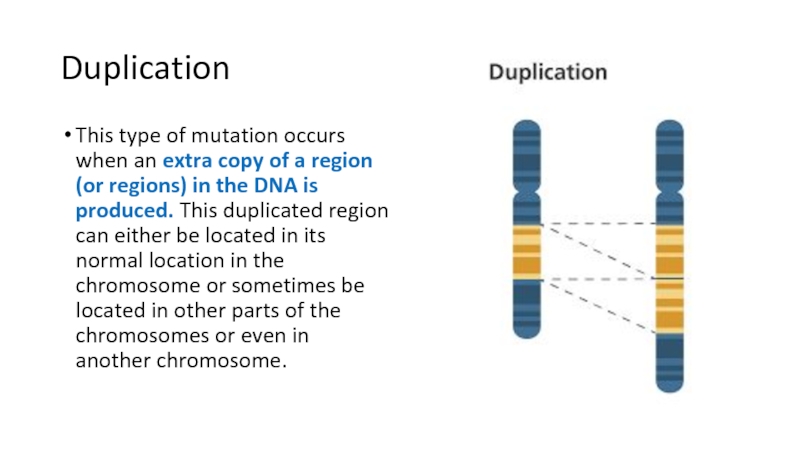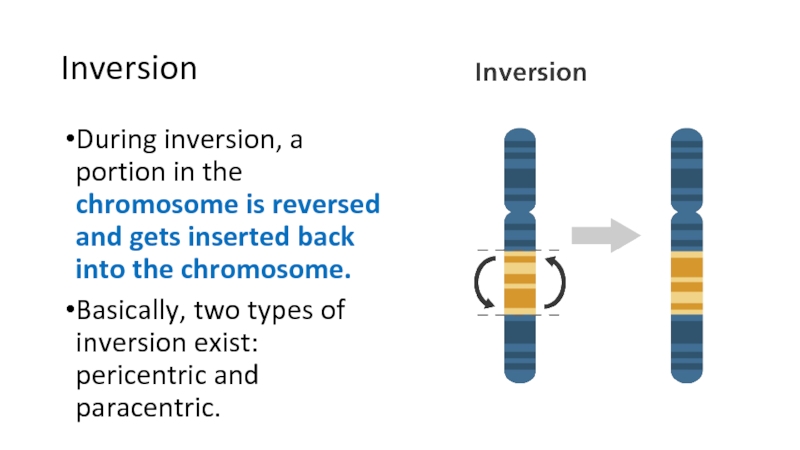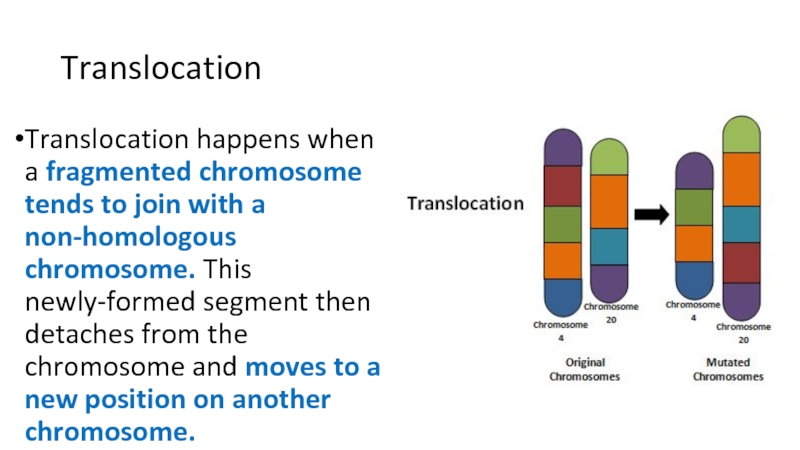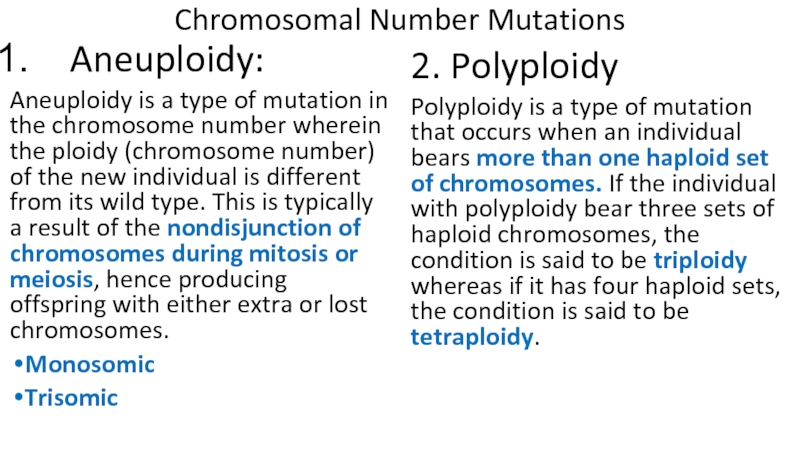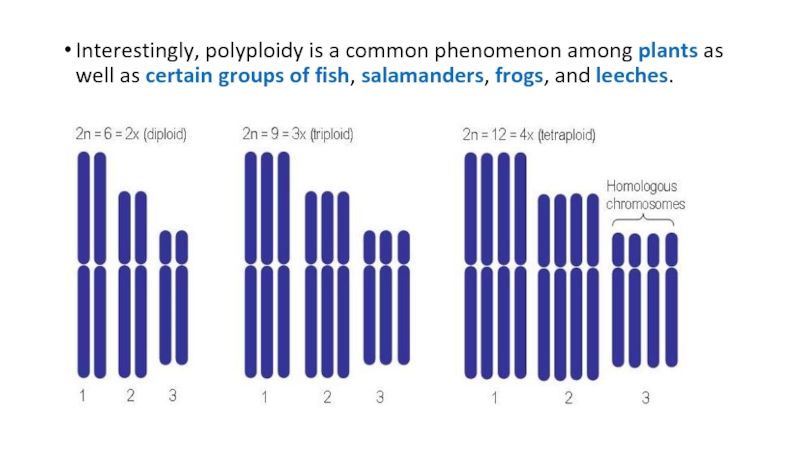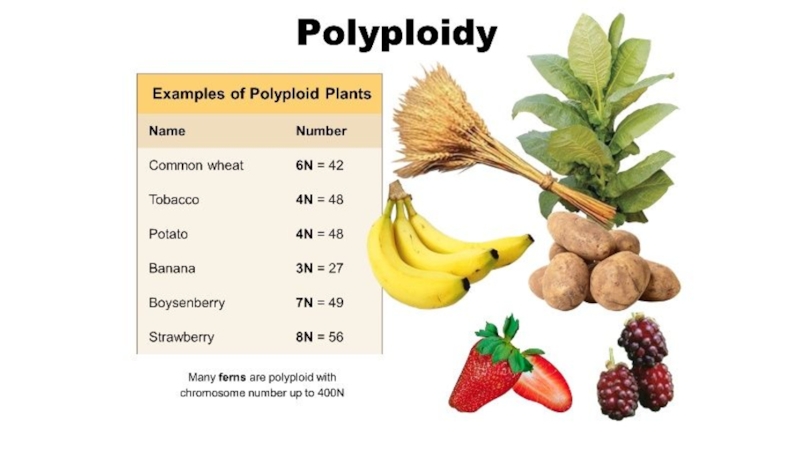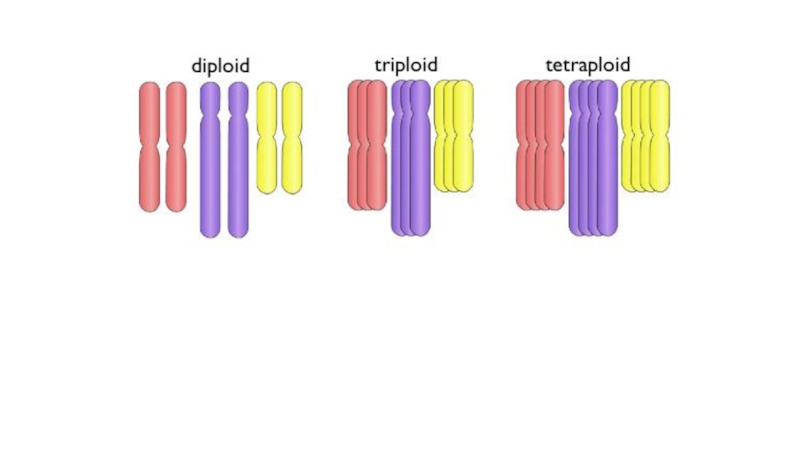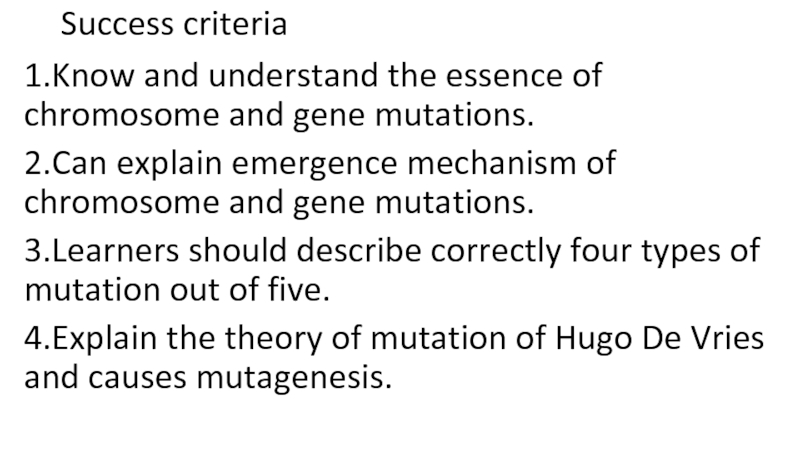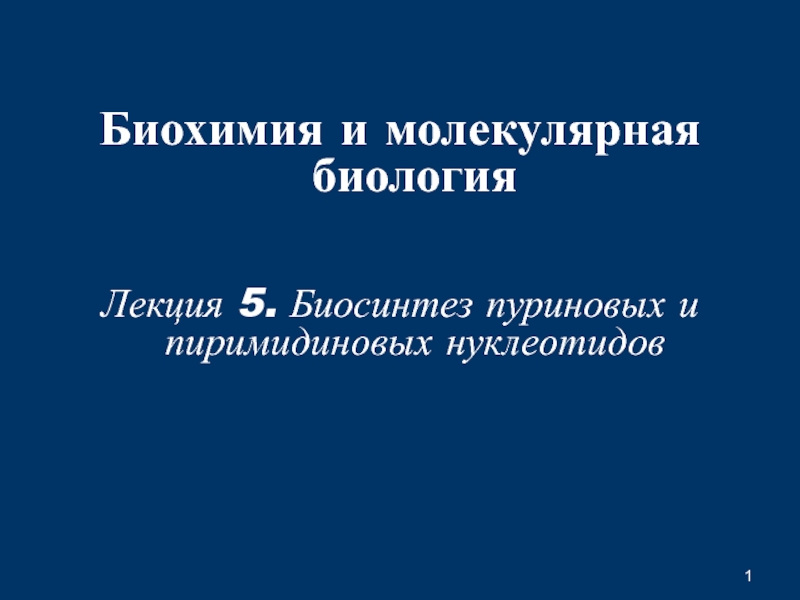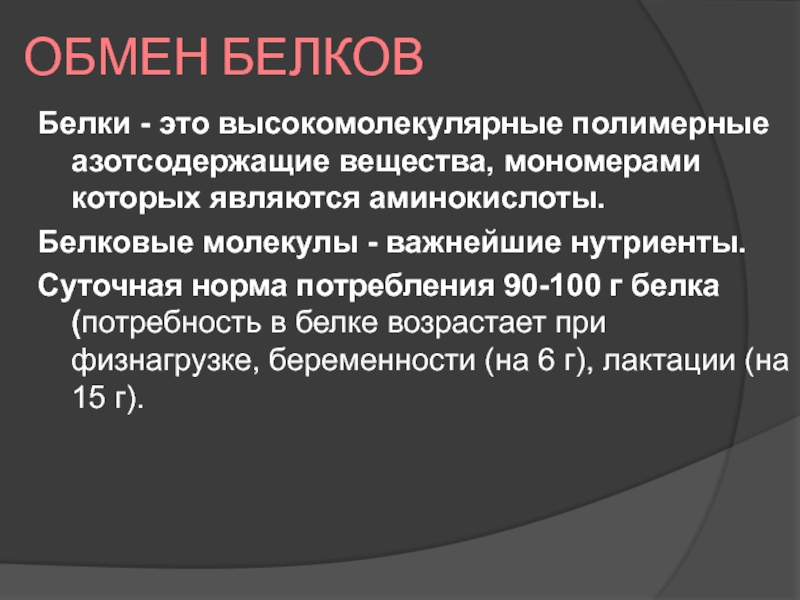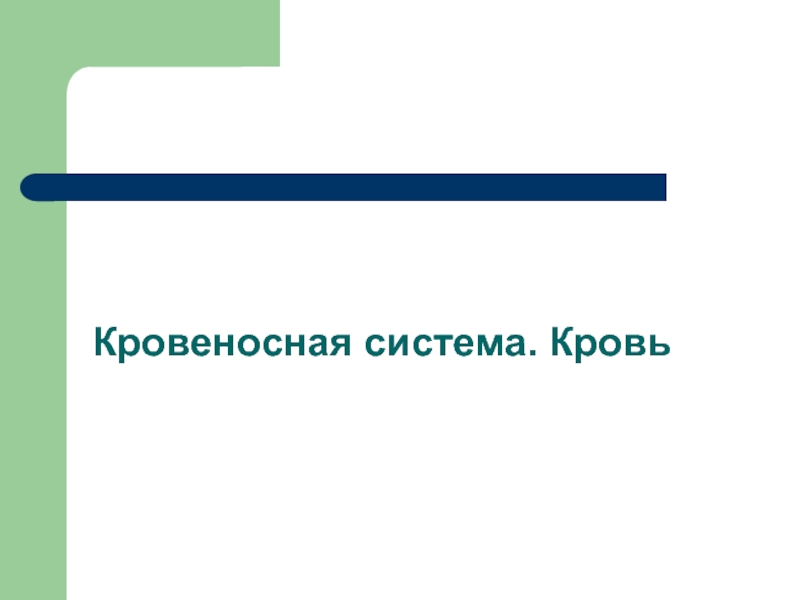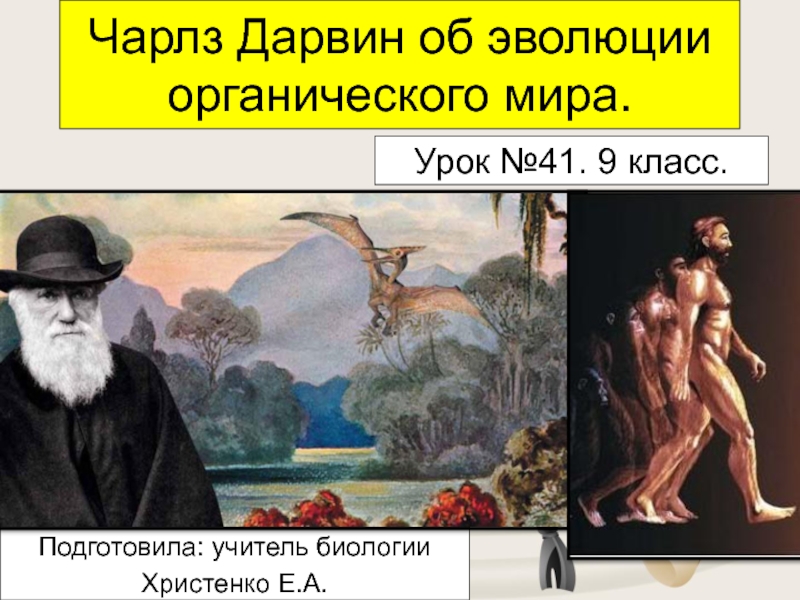- Главная
- Разное
- Дизайн
- Бизнес и предпринимательство
- Аналитика
- Образование
- Развлечения
- Красота и здоровье
- Финансы
- Государство
- Путешествия
- Спорт
- Недвижимость
- Армия
- Графика
- Культурология
- Еда и кулинария
- Лингвистика
- Английский язык
- Астрономия
- Алгебра
- Биология
- География
- Детские презентации
- Информатика
- История
- Литература
- Маркетинг
- Математика
- Медицина
- Менеджмент
- Музыка
- МХК
- Немецкий язык
- ОБЖ
- Обществознание
- Окружающий мир
- Педагогика
- Русский язык
- Технология
- Физика
- Философия
- Химия
- Шаблоны, картинки для презентаций
- Экология
- Экономика
- Юриспруденция
The mechanism of chromosome, gene mutation. The theory of mutation of Hugo De Vries презентация
Содержание
- 2. The mechanism of chromosome, gene mutation. The theory of mutation of Hugo De Vries.
- 3. learning Objectives to explain the mechanism of
- 4. Success criteria 1.Know and understand the
- 5. Terminology Mutation, gene mutation, chromosomal mutation,
- 6. What is a Mutation? Mutation is a
- 8. Hugo De Veirs
- 10. The theory of mutation of Hugo De
- 11. Points in Favour of the Mutation Theory
- 12. Causes of mutagenesis Spontaneous: random changes
- 13. Types of mutation
- 14. Gene mutation Change in the structure of
- 15. The types of mutations include: Gene mutation:
- 16. Point mutation (DNA) Cause by base substitution
- 17. Frame – shift mutation (DNA) caused by
- 20. Types of gene mutations.
- 21. Protein change mutation Missense mutation Nonsense mutation
- 22. Missense mutation This type of mutation is
- 23. Nonsense mutation A nonsense mutation is also
- 24. Insertion An insertion changes the number of
- 25. Deletion A deletion changes the number of
- 26. Duplication A duplication consists of a piece
- 27. Frameshift mutation This type of mutation occurs
- 29. Structural Chromosomal Mutations This happens when homologous
- 31. Deletion This type of mutation occurs
- 32. Duplication This type of mutation occurs
- 33. Inversion During inversion, a portion in
- 34. Translocation Translocation happens when a fragmented chromosome
- 35. Chromosomal Number Mutations Aneuploidy: Aneuploidy is a
- 36. Interestingly, polyploidy is a common phenomenon
- 39. Success criteria 1.Know and understand the
Слайд 3learning Objectives
to explain the mechanism of chromosome, gene mutation
study the theory
Слайд 4Success criteria
1.Know and understand the essence of chromosome and gene
2.Can explain emergence mechanism of chromosome and gene mutations.
3.Learners should describe correctly four types of mutation out of five.
4.Explain the theory of mutation of Hugo De Vries and causes mutagenesis.
Слайд 5Terminology
Mutation, gene mutation, chromosomal mutation, point mutation, deletion, addition, translocation,
Слайд 6What is a Mutation?
Mutation is a change in the nucleotide sequence
In biology, a mutation is the permanent alteration of the nucleotide sequence of the genome of an organism, virus, or extra-chromosomal DNA or other genetic elements.
Mutations result from errors during DNA replication or other types of damage to DNA (such as may be caused by exposure to radiation or carcinogens).
Слайд 10The theory of mutation of Hugo De Vries.
1. Mutations or discontinuous
2. Mutations appear all of a sudden. They become operational immediately.
3. Unlike Darwin’s continuous variations or fluctuations, mutations do not revolve around the mean or normal character of the species.
4. The same type of mutations can appear in a number of individuals of a species.
5. All mutations are inheritable.
6. Mutations appear in all conceivable directions.
7. Useful mutations are selected by nature. Lethal mutations are eliminated. However, useless and less harmful ones can persist in the progeny.
8. Accumulation of variations produce new species. Sometimes a new species is produced from a single mutation.
9. Evolution is a jerky and discontinuous process.
Слайд 11Points in Favour of the Mutation Theory
(1) Mutations are actually the
(2) Mutation theory can explain both progressive and retrogressive evolution.
(3) As the ratio of mutations is not the same in all individuals and their parts, mutation theory can explain the occurrence of both changed and unchanged forms.
(4) A number of mutations have appeared in the past.
Слайд 12Causes of mutagenesis
Spontaneous: random changes to base sequences of gene
Induced: cause by factors – radiation, mutagenic chemicals, high temperature.
Mutagens: X-ray, radioactive isotopes, cosmic rays, UV-light and etc.
Слайд 14Gene mutation
Change in the structure of a DNA molecule, producing a
The DNA sequence of a gene can be altered in a number of ways. Gene mutations have varying effects on health, depending on where they occur and whether they alter the function of essential proteins.
Слайд 15The types of mutations include:
Gene mutation:
Point: Transition, Transversion, Mispairing
Frame – shift:
Missense mutation
Nonsense mutation
Слайд 17Frame – shift mutation (DNA)
caused by indels (insertions or deletions) of
can change the reading frame (the grouping of the codons), resulting in a completely different translation from the original.
the reading of the codons after the mutation to code for different amino acids.
Слайд 22Missense mutation
This type of mutation is a change in one DNA
Слайд 23Nonsense mutation
A nonsense mutation is also a change in one DNA
Слайд 24Insertion
An insertion changes the number of DNA bases in a gene
Слайд 25Deletion
A deletion changes the number of DNA bases by removing a
Слайд 26Duplication
A duplication consists of a piece of DNA that is abnormally
Слайд 27Frameshift mutation
This type of mutation occurs when the addition or loss
Слайд 29Structural Chromosomal Mutations
This happens when homologous chromosomes paired
up, genes in chromosomes
Basically, structural chromosomal mutations are classified into four:
deletion,
duplication,
inversion,
translocation (or shift places).
Слайд 31Deletion
This type of mutation occurs when a part of the
Слайд 32Duplication
This type of mutation occurs when an extra copy of
Слайд 33Inversion
During inversion, a portion in the chromosome is reversed and
Basically, two types of inversion exist: pericentric and paracentric.
Слайд 34Translocation
Translocation happens when a fragmented chromosome tends to join with a
Слайд 35Chromosomal Number Mutations
Aneuploidy:
Aneuploidy is a type of mutation in the chromosome
Monosomic
Trisomic
2. Polyploidy
Polyploidy is a type of mutation that occurs when an individual bears more than one haploid set of chromosomes. If the individual with polyploidy bear three sets of haploid chromosomes, the condition is said to be triploidy whereas if it has four haploid sets, the condition is said to be tetraploidy.
Слайд 36
Interestingly, polyploidy is a common phenomenon among plants as well as
Слайд 39Success criteria
1.Know and understand the essence of chromosome and gene
2.Can explain emergence mechanism of chromosome and gene mutations.
3.Learners should describe correctly four types of mutation out of five.
4.Explain the theory of mutation of Hugo De Vries and causes mutagenesis.
